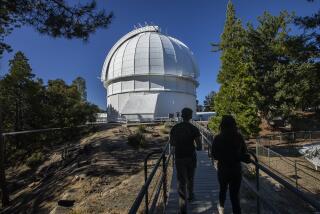Daytime Star-Gazing : Solar Observatory Will Enlighten Students About Our Neglected Neighbor
- Share via
MISSION VIEJO — For years, scientists and would-be astronomers in Orange County had to trek nearly 100 miles to the nearest solar observatory in Big Bear if they wanted to study Earth’s most important star: the sun.
But an astronomy professor at Saddleback Community College here is about to change that.
Starting this semester, the campus will be the permanent home of a new solar observatory, the first one built in Orange County--and the first in the nation to be installed at a community college, according to Saddleback officials.
It will also realize a dream for Yong H. Kim, the astronomy and physics professor who for nearly 10 years lobbied for the observatory at Saddleback.
“The sun is the most important star for us, but at the same time the most forgotten star,” Kim said. “Everybody takes it for granted.”
And even though all life on Earth depends upon it, Kim added, scientists do not completely understand the relationship between the 4.5-billion-year-old star and this planet.
“That is where we can come in,” Kim said. “We’re a small college, but we can participate in a significant way.”
With help from student astronomers and Mitch Haeri, Kim’s former pupil and now a professor of astronomy at Saddleback, the $35,000 mail-ordered, domed observatory is being hand-assembled on the top of the math/science building. It is a modest project, but officials hope it will have far-reaching impact.
When the telescope is completed, the sun’s live image will be transmitted into science classrooms and into the college library, where students can witness solar activity that cannot be seen with the naked eye.
The live images of the sun also will be fed into the college’s World Wide Web site, where anyone on the planet can access them. The telescope can also be converted to a lunar observatory at night, so that images of the moon and other bright planets can be displayed.
“This is live performance,” Kim said. “It’s real-time, real sun.”
The new solar observatory couldn’t have come at a better time.
The sun is entering an 11-year cycle of higher activity, a restless period of sunspots, solar flares and sun storms. Those are the culprits behind the blackouts and major disruptions in radio communications that plague earthlings. The storms also create something of beauty: the awe-inspiring aurora borealis, neon-colored curtains of lights caused by magnetically charged particles emitted by the sun.
All that activity will make for great viewing by students at Saddleback, an experience that both Kim and Haeri hope will turn them on to the sciences.
“It’s going to greatly enhance our teaching ability,” said Haeri, who designed the observatory. “And it will support the entire science discipline at Saddleback.”
Haeri said that because the sun influences Earth’s climate, oceans, biology, and geology, the observatory will be used as a hands-on teaching tool for all 1,000 students in the science department, not just astronomy students.
“As a science educator, I visualize how much curiosity we can generate from students,” Kim added. “We lecture them about these things, but we’re not really showing them. But now this sun is the live one, the real one, in live time. This is the best way to get our students interested.”
For Mehrzad Maghsoudlou, one of the astronomy students helping to assemble the little observatory, it means a chance to finally see the details of Earth’s most intimate star, something he and other local astronomers never had the chance to do because of the scarcity of solar observatories in the area.
*
Despite the abundance of sunshine in Southern California, solar observatories are few and far between, Haeri said. That is because the more intriguing nighttime galaxies and nebulas tend to attract greater attention than their oft-neglected cousin, the sun.
With a diameter of about 865,400 miles, the sun’s surface is 12,000 times larger than that of Earth’s, yet, as stars go, it is considered smaller than average. And although the temperature at the core of the sun is about 20 million degrees centigrade, and 6,000 degrees centigrade at its surface, its temperature is average.
But its impact on Earth is profound, driving our climate and oceans, influencing global warming, and sustaining life from as far away as 93 million miles. Yet, scientists aren’t entirely certain how the sun interacts with Earth.
That is something Kim and his students hope the observatory can help researchers find out.
“I’m very excited about it,” Maghsoudlou said of the new solar facility. “It has the potential to evolve into something truly great.”
That is exactly what Kim and Haeri have in mind.
Despite its deceptively small size--the telescope stands a mere 10 feet high, which is the standard size for a solar telescope--Saddleback’s scientists believe that in time it can have a major impact on the community college.
“Hopefully, something like this can bring prestige to an institution,” said Richard D. McCullough, dean of science, mathematics and engineering. “It will allow our scientists to do real science, which is not always available to a two-year college.”
Already, Kim and Haeri are applying for federal grants to improve the facility to a level where significant solar research can be conducted. They would like to upgrade the telescope, which the college has had stored away for years, and add more sophisticated equipment to the little observatory to be able to study the sun’s spectrum, temperature and pressure.
“The way I’m dreaming now, it will be an observatory that graduate students from nearby universities can use for their dissertations,” Kim said.
Eventually, Kim hopes to be able to participate with other solar facilities around the world in taking and analyzing data from the sun.
“Solar research is not quite as active as other astronomical fields,” Kim said. “So the more data we can get, the more theories we can help formulate. In that sense, our participation is significant.”
Haeri conceded that the college has a long way to go before the observatory is eventually transformed into a sophisticated facility on the same level as those at four-year institutions. And it will never have the same prestige as the world-class solar observatory at Big Bear, which is operated by Caltech, because of the difference of their geographical locations.
The facility at Big Bear is located on a lake, which absorbs heat that would otherwise rise as turbulence and disrupt the sun’s image. In contrast, Saddleback’s observatory must deal with unstable air, which can create a shimmering image of the sun. Haeri said they will try to develop a computer software program for the telescope so the image can be stabilized.
For now, the observatory will be a crucial addition to the college’s teaching tools. In time, the observatory will be open to students from local elementary and high schools around the county, as well as to both amateur stargazers and astrophysicists--and anyone in the world who wants to access it on the Internet.
“I’m very happy at this point,” Kim said, “because finally, this facility is becoming a reality.”
(BEGIN TEXT OF INFOBOX / INFOGRAPHIC)
Here Comes the Sun
Astronomers at Saddleback Community College are building a first for Orange County: a solar telescope. Set atop the math/science building, the scope will track solar activity invisible to the naked eye. A closer look at telescope, dome and solar activity:
The Telescope
A. Wide-angle telescope tracks sun throughout day
B. Foil-like Mylar cover prevents lens from cracking
C. High-tech “film,” similar to computer chip, captures and transmits images
D. Wide lens focuses on full image of sun
E. Narrow lens hones in on particular solar activity
The Dome
Steel dome moves against earth’s rotation to keep sun in full view
Main shutter slides over top of dome
Lower shutter drops open
The Viewers
Images transmitted on monitors in classrooms, labs, library and campus Web site
Solar Activity
Strong magnetic fields cause solar activity to form within the photosphere, the sun’s visible surface. By predicting solar activity, scientists can determine when satellite communications may be disrupted. Images of solar activity are transmitted every thirtieth of a second, allowing observers to study solar activity as it occurs:
Flare: Huge explosion on the sun; can disrupt communications
Prominence: Small explosion on the edge of the sun
Sunspot: Cooler region of sun’s surface that appears darker; increasing numbers precede flares
Fast Facts
Saddleback astronomy professor Dr. Yong Kim lobbied for nearly a decade to get a solar telescope at his campus. Some other details of the project:
Dome cost: $11,000
Equipment cost: $24,000
Project began: October 1995
Expected completion: May 1996
Quotable
“The face of the sun is constantly changing. With this telescope, we can observe these changes in real time on a day-to-day basis.”--Dr. Mitch Haeri, former student of Dr. Yong H. Kim, currently professor of astronomy at Saddleback College
Electric Address
To access solar images from telescope, use college’s Web site: https://www.saddleback.cc.ca.us/div/mse/
Source: Saddleback Community College, World Book Encyclopedia and Academic American Encyclopedia; Researched by APRIL JACKSON / Los Angeles Times






